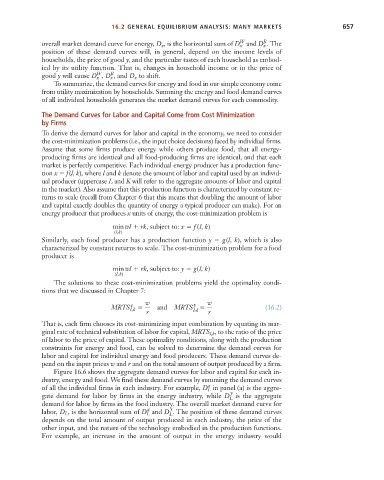Page 683 - Microeconomics, Fourth Edition
P. 683
c16GeneralEquilibriumTheory.qxd 8/16/10 9:13 PM Page 657
16.2 GENERAL EQUILIBRIUM ANALYSIS: MANY MARKETS 657
B
, is the horizontal sum of D W and D . The
overall market demand curve for energy, D x x x
position of these demand curves will, in general, depend on the income levels of
households, the price of good y, and the particular tastes of each household as embod-
ied by its utility function. That is, changes in household income or in the price of
B
W
good y will cause D , D , and D to shift.
x
x
x
To summarize, the demand curves for energy and food in our simple economy come
from utility maximization by households. Summing the energy and food demand curves
of all individual households generates the market demand curves for each commodity.
The Demand Curves for Labor and Capital Come from Cost Minimization
by Firms
To derive the demand curves for labor and capital in the economy, we need to consider
the cost-minimization problems (i.e., the input choice decisions) faced by individual firms.
Assume that some firms produce energy while others produce food, that all energy-
producing firms are identical and all food-producing firms are identical, and that each
market is perfectly competitive. Each individual energy producer has a production func-
tion x f(l, k), where l and k denote the amount of labor and capital used by an individ-
ual producer (uppercase L and K will refer to the aggregate amounts of labor and capital
in the market). Also assume that this production function is characterized by constant re-
turns to scale (recall from Chapter 6 that this means that doubling the amount of labor
and capital exactly doubles the quantity of energy a typical producer can make). For an
energy producer that produces x units of energy, the cost-minimization problem is
minwl rk, subject to: x f (l, k)
(l, k)
Similarly, each food producer has a production function y g(l, k), which is also
characterized by constant returns to scale. The cost-minimization problem for a food
producer is
min wl rk, subject to: y g(l, k)
(l, k)
The solutions to these cost-minimization problems yield the optimality condi-
tions that we discussed in Chapter 7:
w y w
x
MRTS l, k and MRTS , k (16.2)
r l r
That is, each firm chooses its cost-minimizing input combination by equating its mar-
ginal rate of technical substitution of labor for capital, MRTS , to the ratio of the price
l,k
of labor to the price of capital. These optimality conditions, along with the production
constraints for energy and food, can be solved to determine the demand curves for
labor and capital for individual energy and food producers. These demand curves de-
pend on the input prices w and r and on the total amount of output produced by a firm.
Figure 16.6 shows the aggregate demand curves for labor and capital for each in-
dustry, energy and food. We find these demand curves by summing the demand curves
x
of all the individual firms in each industry. For example, D L in panel (a) is the aggre-
gate demand for labor by firms in the energy industry, while D L y is the aggregate
demand for labor by firms in the food industry. The overall market demand curve for
x y
labor, D L , is the horizontal sum of D L and D L . The position of these demand curves
depends on the total amount of output produced in each industry, the price of the
other input, and the nature of the technology embodied in the production functions.
For example, an increase in the amount of output in the energy industry would

